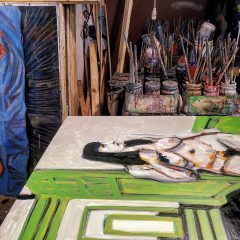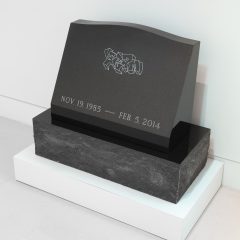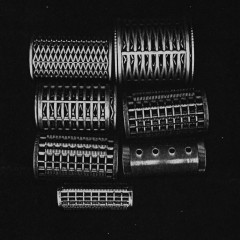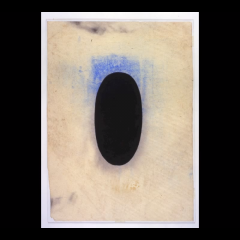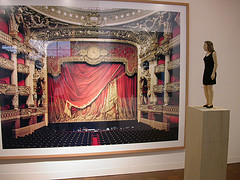
Image is a Stephan Balkenhol carving and a Candida Hofer photograph from Pier 90 at the Armory Show. The small figure seeming to look at the big picture is kind of how I felt when I walked around the huge international show.
We went to the Armory Show Thursday afternoon. And for four hours we marched up and down Pier 92 and Pier 90 on the Hudson River looking at work in 154 booths by exhibitors from around the world. What struck me most (apart from the weariness factor of being bombarded visually by all that stuff) was the sheer volume of museum-class work for sale.
Alex Katz seemed to have paintings in numerous galleries on both piers, a hint at how the secondary market works. Buy it here, sell it there, make some dough.
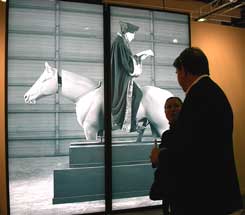
Rodney Graham lightbox. One of my favorites in the show.
Not all the work by the museum-certified artists was uniformly wonderful. We saw a great Alice Neel painting, and a not so fabulous one.
Libby and I got most excited when we saw excellent things that were new to us. That didn’t happen so often in the Armory. (But it did in the Pulse Contemporary Art Show (and more on that in another post).
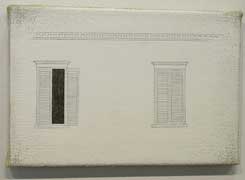
Ugo Rondinone drawing on linen, Armory show. $13,000, probably sold immediately.
Two conversations I overheard clued me in to how fast things sell. Three small Ugo Rondinone drawings were up at Matthew Marks’ booth and a collector was asking the price. $13,000. They were brand new according to the gallery assistant who said the artist had just delivered them the previous evening. The drawings looked like pencil on gessoed linen, very small, and were architectural, describing a window or two, a set of stairs — mere suggestions of building facades.
The collector probed the gallery attendant “Which one do you like? Which one do you think is best?” Questions whose subtext was more about money than taste methinks. The collector said he’d be back in a half hour. I’m sure those little works got sold immediately — to him or to some other collector.
I was happy when I saw familiar work by artists I like: Stephan Balkenhol, Gabriel Orozco, Tony Oursler, Candida Hofer, some 2006 Biennial hotshots like Mark Bradford.
Many artists whom we’ve seen in shows like the Carnegie International were represented: Katarzyna Kozyra, Omer Fast, Kutlag Ataman.
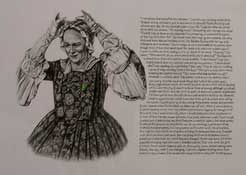
Omer Fast’s drawing of a colonial type. The words are about an imagined conversation/encounter between him and the person.
Fast had a wonderful set of drawings of historical-types (a colonial woman, a cowboy etc). Each one was accompanied by a hand-pencilled story in which the artist attempts to converse across time, space and culture, with the stereotyped character. The stories were wry and wonderful and the drawings were great.
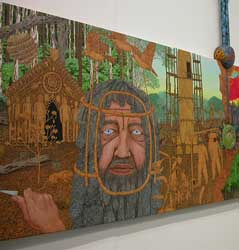
James Morrison’s multi-panel painting, detail.
Occasionally there was actually something new and exciting and that was fun. Like when we saw work by Australian artist James Morrison in Darren Knight’s Gallery booth. The artist had a two-wall-spanning panel painting that told a mythic story and mixed western drawing styles with Aboriginal motifs. Very nice.
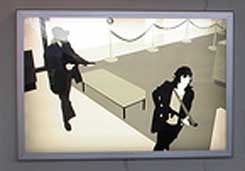
Koto Ezawa light box showing the surveillance footage from the Patti Hearst/SLA armed robbery in the 1970s. Ezawa, who alters source material from television to make political points, had a great piece at Vox Populi a while back. That one wasbased on the OJ Simpson trial and showed OJ with shifty eyes looking back and forth as the not guilty verdict is read.
Here’s the conversation I overheard about some smaller works by Morrison. A collector who must have been a dealer too (she had a website)was looking for a discount since she wanted more than one piece. She asked for 20%. He said 10%. She countered 15% and he stuck with 10%, saying, “They’re not that expensive.” He got the last word as she agreed. He said he’d take care of her and that he’d send the works to her from Australia.
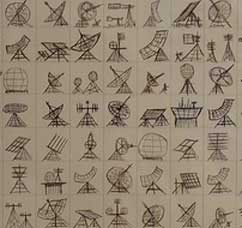
Russell Crotty, ciphers drawiing. Crotty made those wonderful enormous books of drawings of the night sky that appeared in MoMA’s Drawing Now exhibit some years back.
I will close this post here and come back with some more pictures. And here’s the link to my flickr set which has some 120 pix from the Armory. Here’s Libby’s set.
If I had more of an mba mindset I would have gotten more into the commerce of art which is of course what this is all about. I look forward to reading the business-savvy accounts to tell me what I missed.
If you’re not buying, selling or researching the sales, the Armory is like window shopping at Nieman Marcus — a mildly frustrating experience not to be done too often.


